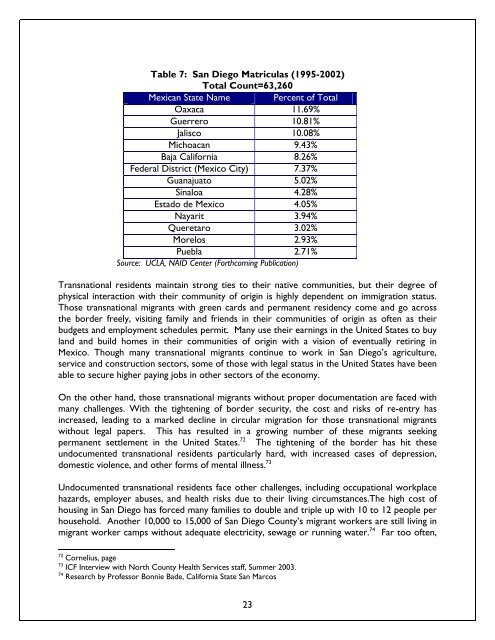Blurred Borders - International Community Foundation
Blurred Borders - International Community Foundation
Blurred Borders - International Community Foundation
Create successful ePaper yourself
Turn your PDF publications into a flip-book with our unique Google optimized e-Paper software.
Table 7: San Diego Matriculas (1995-2002)<br />
Total Count=63,260<br />
Mexican State Name Percent of Total<br />
Oaxaca 11.69%<br />
Guerrero 10.81%<br />
Jalisco 10.08%<br />
Michoacan 9.43%<br />
Baja California 8.26%<br />
Federal District (Mexico City) 7.37%<br />
Guanajuato 5.02%<br />
Sinaloa 4.28%<br />
Estado de Mexico 4.05%<br />
Nayarit 3.94%<br />
Queretaro 3.02%<br />
Morelos 2.93%<br />
Puebla 2.71%<br />
Source: UCLA, NAID Center (Forthcoming Publication)<br />
Transnational residents maintain strong ties to their native communities, but their degree of<br />
physical interaction with their community of origin is highly dependent on immigration status.<br />
Those transnational migrants with green cards and permanent residency come and go across<br />
the border freely, visiting family and friends in their communities of origin as often as their<br />
budgets and employment schedules permit. Many use their earnings in the United States to buy<br />
land and build homes in their communities of origin with a vision of eventually retiring in<br />
Mexico. Though many transnational migrants continue to work in San Diego’s agriculture,<br />
service and construction sectors, some of those with legal status in the United States have been<br />
able to secure higher paying jobs in other sectors of the economy.<br />
On the other hand, those transnational migrants without proper documentation are faced with<br />
many challenges. With the tightening of border security, the cost and risks of re-entry has<br />
increased, leading to a marked decline in circular migration for those transnational migrants<br />
without legal papers. This has resulted in a growing number of these migrants seeking<br />
permanent settlement in the United States. 72 The tightening of the border has hit these<br />
undocumented transnational residents particularly hard, with increased cases of depression,<br />
domestic violence, and other forms of mental illness. 73<br />
Undocumented transnational residents face other challenges, including occupational workplace<br />
hazards, employer abuses, and health risks due to their living circumstances.The high cost of<br />
housing in San Diego has forced many families to double and triple up with 10 to 12 people per<br />
household. Another 10,000 to 15,000 of San Diego County’s migrant workers are still living in<br />
migrant worker camps without adequate electricity, sewage or running water. 74 Far too often,<br />
72 Cornelius, page<br />
73 ICF Interview with North County Health Services staff, Summer 2003.<br />
74 Research by Professor Bonnie Bade, California State San Marcos<br />
23















